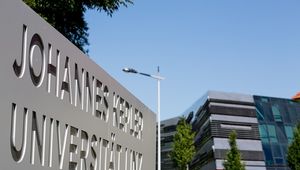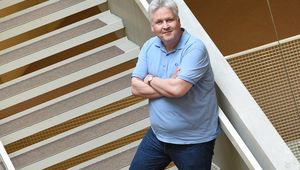The prestigious 2022 E&T Innovation Award for "Best Emerging Technology of the Year" was presented in recognition of the outstanding “Virtual Anatomy” project!

The project also won a second-place award in another category. Developed by the Ars Electronica Futurelab in partnership with Siemens Healthineers and the Johannes Kepler University Linz, the “Virtual Anatomy” space turns cross-sectional MRI and CT data provided by actual patients into photorealistic, three-dimensional human anatomical images. JKU Rector Meinhard Lukas accepted the trophy in London yesterday evening during an awards ceremony.
Presented annually in recognition of outstanding innovation in the fields of science, engineering, and technology, the internationally distinguished E&T Innovation Awards, opens an external URL in a new window are highly prized, demonstrated by the fact that the chief technologist from mobile communications company Ericsson travelled to the awards ceremony personally to accept an award.
“Virtual Anatomy” was among the finalists in two categories, winning a trophy (1st prize) in the category of: "Best Emerging Technology of the Year", and a second-place award in the category: "Most Innovative Solution in Digital Health and Social Care".
“Virtual Anatomy” displays actual MRI and CT patient data in an entirely new way, namely as photorealistic, 8K stereoscopic 3D images with an option to freely rotate the images, zooming in on the smallest structures. In the area of anatomical education and training in particular, the technology opens the door to new and unprecedented possibilities, as strikingly demonstrated by the use of “Virtual Anatomy” at the JKU medSPACE since last year.
JKU Rector Meinhard Lukas remarked: "Being presented with a prestigious international award in recognition of the ‘Virtual Anatomy’ project shows that having the courage to take innovation approaches pays off in every respect. While our students undoubtedly benefit from a cutting-edge medical degree program, Upper Austria also benefits, strengthening our region as a location of research and showing just what our young school of medicine is capable of. I would like to congratulate everyone involved, particularly Prof. Franz Fellner and our partners, and I am delighted and very proud that our joint project is continuing to attract international attention after being nominated for the 2017 German Future Award. I am thrilled that we have succeeded in bringing ‘Virtual Anatomy’ to life at JKU medSPACE!"
Roland Haring, Technical Director at the Ars Electronica Futurelab, is equally delighted about the award and added: "We are very excited and pleased that our partnership is revolutionizing medical education – and not just in Austria. The international recognition in the form of the E&T Innovation Award is remarkable. As a Futurelab, we work together with a number of partners in Austria and abroad to create technology of the future and we foresee and anticipate many applications in support of ‘Virtual Anatomy’ in research and education."
Virtual Anatomy: A Success Story
Innovative projects, such as “Virtual Anatomy”, can only succeed when several parties at different institutions pull together and work closely over a number of years. Initiated by Prof. Franz Fellner (Dean at the JKU’s Faculty of Medicine and head of the Central Radiology Institute at the Kepler University Hospital), the “Virtual Anatomy” space was created with the experts at the Ars Electronica Futurelab and in partnership with Siemens Healthineers. In 2015, and with the help of Siemens' "Cinematic Rendering" software, the 16-by-9-meter Deep Space 8K at the Ars Electronica Center turned into a “Virtual Anatomy” classroom for the first time and subsequently, JKU medical students then regularly attended classroom lectures there. The space was also used for public presentations about anatomy for laypersons, and also live-streamed operations and surgical procedures. The lectures enjoyed great success, bringing the JKU, Ars Electronica Futurelab, and Siemens Healthineers together again to create a research-based partnership focused on designing the JKU medSPACE at JKU's new Medical Campus. The state-of-the-art multimedia classroom opened its doors in September 2021.
Horst Hörtner, director at the Ars Electronica Futurelab, stated: "All of us here at the Ars Electronica Futurelab are immensely proud of this joint ‘Virtual Anatomy’ project! It has blown the door wide open to the future of academic education in human anatomy here in Linz."
Actual Patient Data
“Virtual Anatomy” is unique and unusual in that classroom instruction includes working with data provided by actual patients instead of just studying standard, 3D anatomical models. True patient data, acquired using CT and MRI machines at the Kepler University Hospital, can be displayed in high-definition photographic quality in 8K, stereographic and is navigable in real time.
Klaus Engel, Senior Principal Key Expert at Siemens Healthineers, affirmed: "We developed the 'cinematic rendering' that provides photorealistic, three-dimensional body images in which even the most very fine structures appear clearly and vividly. When combined with the corresponding measurement data, such as PET computed tomography, for example, functional information, such as the body’s metabolism, can be depicted."
Students and Medical Professional Acquire New Insight and Perspectives
The clinical data visualization is very vivid and clear, making it easier for doctors to explain physical damage, diagnose illnesses, or explain the course of a scheduled operation to patients. The method facilitates previously unimaginable anatomical detail, such as depicting fibers in the human brain at a level of detail invisible to the naked eye, and can also be applied to educate and train medical students, therapists, and nurses. The option to rotate realistic-looking, real patient 3-D images as desired - and process the images for a particular educational purpose - is also unique.
Franz Fellner, Dean of the JKU’s Faculty of Medicine and head of Radiology at the Kepler University Hospital, surmised: "Virtual Anatomy allows us to educate students in a whole new cutting-edge, three-dimensional way using cross-sectional CT and MR images. Our concept enables students to learn to read different languages, so to say, because they are learning about anatomy by looking at it from different angles. Three-dimensional, high resolution, anatomical projection featuring 'cinematic rendering' is undoubtedly globally unique, giving us new educational opportunities as well as boosting the students' interest in anatomy, even more than it already is. I am incredibly pleased that this project has been recognized. The award validates our approach to combine digital and analog instruction in a beneficial way."
Click here, opens an external URL in a new window for an introduction to Virtual Anatomy at JKU medSPACE.
Based on the Virtual Anatomy project, Siemens Healthineers have also developed the Cinematic Anatomy solution, an application to support digital and immersive learning in the subject area of anatomy and during various, scalable expansion stages. Click here, opens an external URL in a new window to learn more.
 Go to JKU Homepage
Go to JKU Homepage












![Innovation Award Verleihung in London mit Rektor Meinhard Lukas [Translate to Englisch:] Innovation Award Verleihung in London](/fileadmin/_processed_/0/f/csm_E_T_Awards_Sieger_24974ba932.jpg)




